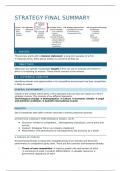Summary
Summary strategy (premaster, TISEM)
- Course
- Institution
- Book
17-Page Summary on Strategic Management and Competitive Advantage This 17-page summary distills essential insights from key academic works on strategic management and competitive advantage. It includes critical perspectives on collaboration from Collaboration Reduces Contentions (Odziemkowska & ...
[Show more]




